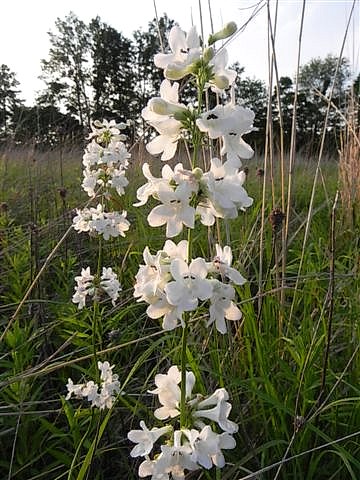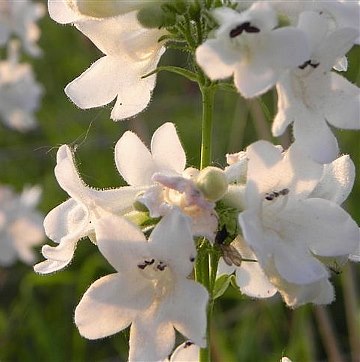Description: This perennial plant is 2-3' tall, forming one or more unbranched flowering stalks. The central stem is light green, glabrous, and terete. Pairs of opposite leaves develop along the lower half of this stem; they are up to 5" long and 2" across, deltate-ovate to oblong-lanceolate in shape, and smooth to slightly toothed along their margins. Between the leaves on the lower stem and the inflorescence, the central stem is usually naked; sometimes pairs of small narrow leaves (1" long or less) can be found along the upper stem that resemble bracts. The upper surface of the leaves is medium to dark green and glabrous, while the lower surface is pale green and glabrous.

The inflorescence
consists of a cylindrical panicle of flowers about ½-1½' in length.
Within this inflorescence, the flowers are clustered together at
intervals in pseudo-whorls (about 6-12 flowers per pseudo-whorl).
Individual flowers are about ¾-1" long and across, consisting of a
funnel-shaped white corolla that flares outward into 5 rounded lobes, a
small green calyx with 5 ovate teeth, 5 stamens (one of them sterile),
and a pistil with a single style. Tiny glandular hairs occur along the
outside and inside of the corolla. The peduncles and pedicels of the
flowers are either glabrous or glandular-hairy. The blooming period
occurs from late spring to early summer and lasts about 3 weeks. The
flowers are replaced by ovoid seed capsules about 1/3" long; the latter
eventually split open to release numerous small seeds. The root system
consists of a crown with fibrous roots. Low basal leaves are usually
present during winter dormancy.
Cultivation:
The preference is full or partial sun, mesic to dry conditions, and
loamy or rocky soil. Well-drained conditions are required to prevent
root rot.

Range &
Habitat:
Trumpet Penstemon is uncommon in southern Illinois, and rare or absent
in the rest of the state (see Distribution
Map). Illinois lies near the northeast range-limit of this
species. Habitats include meadows and openings in upland woodlands, oak
savannas, thinly wooded bluffs, prairies, limestone glades, and prairie
remnants along railroads.
Faunal Associations:
The nectar and pollen of the flowers attract long-tongued bees
primarily: bumblebees, Anthophorine bees (Anthophora spp.),
a Mason bee (Osmia distincta), and a wasp (Pseudomasaris
occidentalis). The last two insects are oligoleges of Penstemon
spp. (Penstemons). Other floral visitors include Green
Metallic bees (collect pollen only) Swallowtail butterflies (suck
nectar only), and the Ruby-Throated Hummingbird (suck nectar only).
Moth caterpillars that feed on Penstemons include Elaphria
chalcedonia (Chalcedony Midget), Oncocnemis
saudersiana (Saunder's Oncocnemis), and Pyrrhia
exprimens (Purple-Lined Sallow). Mammalian herbivores
apparently make little use of the foliage as a food source.

Photographic
Location:
A prairie in Fayette County, Illinois. The photographs were taken by
Keith & Patty Horn (Copyright © 2010).
Comments:
Trumpet Penstemon is an elegant wildflower with an unusually long and
slender inflorescence. In addition to these characteristics of its
inflorescence, it differs from other Penstemon spp.
(Penstemons) by the shape of its flowers (narrow and funnel-shaped at
the base, rather than swollen), the large size and similarity of its
corolla lobes, the lack of conspicuous leaves between the inflorescence
and the leaves of the lower stem, the presence of tiny glandular hairs
within its corolla, and the lack of hairs on its leaves and central
stalk. Sometimes the scientific name of this species is spelled Penstemon
tubiflorus (see Britton & Brown, 1913/1970).